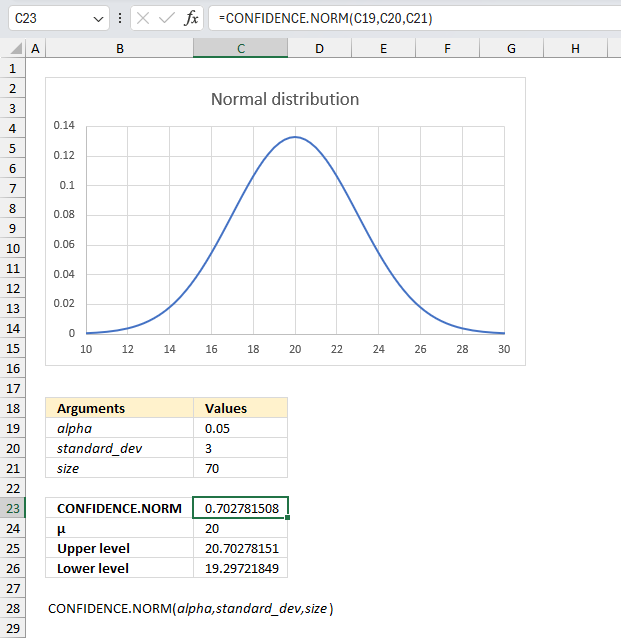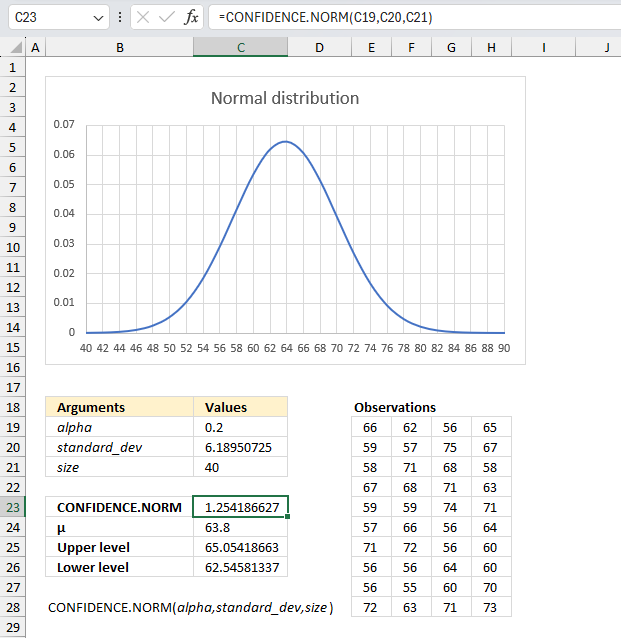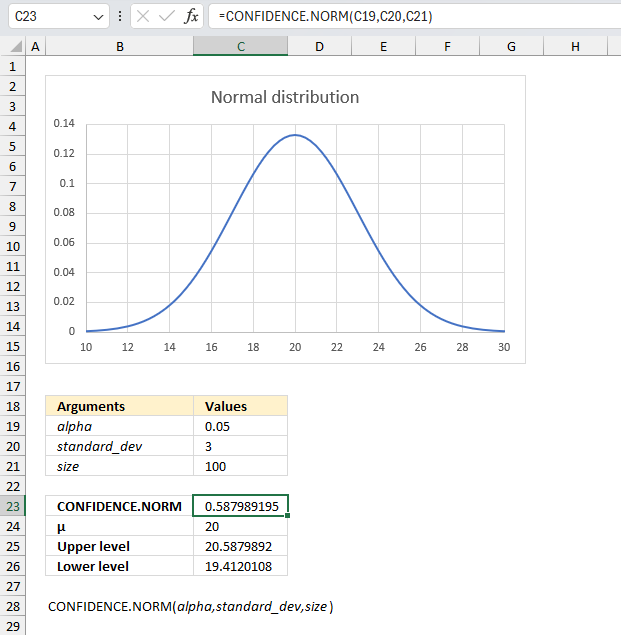How to use the CONFIDENCE.NORM function

What is the CONFIDENCE.NORM function?
The CONFIDENCE.NORM function calculates the confidence interval for a population mean. In other words it calculates the margin of error, if the mean is μ then the confidence interval is μ ± CONFIDENCE.NORM.
Use the CONFIDENCE.NORM function when you have more than 30 observations. The CONFIDENCE.T function is for less than 30 observations, it accounts for the increased uncertainty associated with small sample sizes.
Table of Contents
1. Introduction
What is a confidence interval?
A confidence interval provides a range of plausible values for an unknown population parameter like a mean, based on a sample estimate and how much variability exists around that estimate. It is indicating the reliability of the estimate at a specified confidence level.
What is a population mean?
A population mean commonly represented by the Greek letter mμ is the arithmetic average value in a statistical population. It is estimated using the sample mean taken from a representative random sample of the entire population.
What is the variability?
Variability refers to the dispersion or spread of values in a data set and their tendency to deviate from the central mean value. It is quantified by statistical measures like variance, standard deviation, and interquartile range.
What is the arithmetic average value in a statistical population?
The arithmetic average value in a statistical population is the population mean, commonly represented by the Greek letter mu. It is equal to the sum of all the individual values divided by the total number of elements in the full population.
What is the difference between the CONFIDENCE.T function and the CONFIDENCE.NORM function?
The CONFIDENCE.NORM function calculates the confidence interval for a population mean using the normal distribution whereas the CONFIDENCE.T function calculates the confidence range for a population mean using a Student's t distribution.
CONFIDENCE.NORM(alpha,standard_dev,size)
CONFIDENCE.T(alpha,standard_dev,size)
2. Syntax
CONFIDENCE.NORM(alpha,standard_dev,size)
3. Arguments
| alpha | Required. The significance level. |
| standard_dev | Required. The standard deviation. |
| size | Required. The number of samples. |
What is the significance level?
The significance level, denoted α (alpha) , is the probability of mistakenly rejecting the null hypothesis when it is in fact true. It is providing a threshold used to judge whether sample evidence is sufficient to indicate a real effect or relationship.
What is standard deviation?
Standard deviation measures the amount of variation or dispersion of values in a dataset relative to the mean. It is calculated as the square root of the variance by taking
- each data point's deviation from the mean
- squaring it
- averaging the squares
- finally square rooting the result
STDEV.P function in Excel calculates the standard deviation.
4. Example 1

You study plants, you have 70 plants in your inventory. The average height is 20 cm, and the standard deviation σ is 3 cm. How to estimate the mean μ height with a 95% confidence level?
The CONFIDENCE.NORM function lets you calculate the interval that satisfies a given a significance level, standard deviation and a number representing the population size.
The image above shows the argument:
- alpha in cell C19 which is 1-0.95 = 0.05
- standard_dev in cell C20 = 3
- size in cell C21 = 70
Formula in cell C23:
The CONFIDENCE.NORM function returns 0.702781508276192 for the specified arguments above.We can now calculate the upper and lower limit by adding the confidence interval from cell C23 to the mean μ. I have done this in cell C25:
The lower limit is calculated by subtracting the confidence level to the mean μ. Cell 26:
In other words, there is a 95% probability that the mean μ is between approx. 19.297 and approx. 20.703
5. Example 2

You work as an engineer at a company manufacturing electronic equipment. You have made 40 temperature measurements from one of the machines.
The measurements are in cell range E19:H28 displayed in the image above. The table below shows the same values:
| 66 | 59 | 58 | 67 | 59 | 57 | 71 | 56 | 56 | 72 |
| 62 | 57 | 71 | 68 | 59 | 66 | 72 | 56 | 55 | 63 |
| 56 | 75 | 68 | 71 | 74 | 56 | 56 | 64 | 60 | 71 |
| 65 | 67 | 58 | 63 | 71 | 64 | 60 | 60 | 70 | 73 |
How to estimate the mean μ temperature interval with a 80% confidence level?
The CONFIDENCE.NORM function requires three arguments, the alpha, standard deviation and the size. The alpha is specified in question, 1 - 0.8 = 0.2
We can calculate the mean μ using the AVERAGE function. Formula in cell C24:
The average is calculated by adding all the measurements and then divide by the number of observations. The standard deviation is also easy to calculate in Excel. Formula in cell C25:
Here is how the STDEV.P function calculates the standard deviation:

We now have all the arguments needed to calculate the interval that satisfies a given significance level at 80% (0.8).
- alpha in cell C19 which is 1-0.8 = 0.2
- standard_dev in cell C20 approx. equal to 6.19
- size in cell C21 = 40
Formula in cell C23:
The CONFIDENCE.NORM function returns 1.25418662730462 for the specified arguments above. We can now calculate the upper and lower limit by adding the confidence interval from cell C23 to the mean μ. I have done this in cell C25:
The lower limit is calculated by subtracting the confidence level to the mean μ. Cell 26:
In other words, there is a 80% probability that the mean μ is between approx. 62.55 and approx. 65.05
6. Example 3

This example builds on the first example in section 4.
A year has gone since you made your last calculations. You now have 100 plants in your inventory. The average height is 20 cm, and the standard deviation σ is 3 cm. How to estimate the mean μ height with a 95% confidence level?
The only thing that has changed is the number of plants (size). Lets see if that changes the confidence interval.
The image above shows the argument, only one has changed and that one is in cell C21:
- alpha in cell C19 which is 1-0.95 = 0.05
- standard_dev in cell C20 = 3
- size in cell C21 = 100
Formula in cell C23:
The CONFIDENCE.NORM function returns approx. 0.588 for the specified arguments above. The interval is smaller which is understandable since the sample size has grown to 100.
There is a 95% probability that the mean μ is between approx. 19.41 and approx. 20.59. The interval is smaller which makes sense considering the size is larger.
7. Function not working

The CONFIDENCE.NORM function returns:
- #VALUE! error value if any argument is non-numeric.
- #NUM! error value if
- alpha <= 0 (zero) or alpha >= 1.
- standard_dev <= 0.
- size < 1.
The function truncates size numbers to integers.
7.1 Troubleshooting the error value

When you encounter an error value in a cell a warning symbol appears, displayed in the image above. Press with mouse on it to see a pop-up menu that lets you get more information about the error.
- The first line describes the error if you press with left mouse button on it.
- The second line opens a pane that explains the error in greater detail.
- The third line takes you to the "Evaluate Formula" tool, a dialog box appears allowing you to examine the formula in greater detail.
- This line lets you ignore the error value meaning the warning icon disappears, however, the error is still in the cell.
- The fifth line lets you edit the formula in the Formula bar.
- The sixth line opens the Excel settings so you can adjust the Error Checking Options.
Here are a few of the most common Excel errors you may encounter.
#NULL error - This error occurs most often if you by mistake use a space character in a formula where it shouldn't be. Excel interprets a space character as an intersection operator. If the ranges don't intersect an #NULL error is returned. The #NULL! error occurs when a formula attempts to calculate the intersection of two ranges that do not actually intersect. This can happen when the wrong range operator is used in the formula, or when the intersection operator (represented by a space character) is used between two ranges that do not overlap. To fix this error double check that the ranges referenced in the formula that use the intersection operator actually have cells in common.
#SPILL error - The #SPILL! error occurs only in version Excel 365 and is caused by a dynamic array being to large, meaning there are cells below and/or to the right that are not empty. This prevents the dynamic array formula expanding into new empty cells.
#DIV/0 error - This error happens if you try to divide a number by 0 (zero) or a value that equates to zero which is not possible mathematically.
#VALUE error - The #VALUE error occurs when a formula has a value that is of the wrong data type. Such as text where a number is expected or when dates are evaluated as text.
#REF error - The #REF error happens when a cell reference is invalid. This can happen if a cell is deleted that is referenced by a formula.
#NAME error - The #NAME error happens if you misspelled a function or a named range.
#NUM error - The #NUM error shows up when you try to use invalid numeric values in formulas, like square root of a negative number.
#N/A error - The #N/A error happens when a value is not available for a formula or found in a given cell range, for example in the VLOOKUP or MATCH functions.
#GETTING_DATA error - The #GETTING_DATA error shows while external sources are loading, this can indicate a delay in fetching the data or that the external source is unavailable right now.
7.2 The formula returns an unexpected value

To understand why a formula returns an unexpected value we need to examine the calculations steps in detail. Luckily, Excel has a tool that is really handy in these situations. Here is how to troubleshoot a formula:
- Select the cell containing the formula you want to examine in detail.
- Go to tab “Formulas” on the ribbon.
- Press with left mouse button on "Evaluate Formula" button. A dialog box appears.
The formula appears in a white field inside the dialog box. Underlined expressions are calculations being processed in the next step. The italicized expression is the most recent result. The buttons at the bottom of the dialog box allows you to evaluate the formula in smaller calculations which you control. - Press with left mouse button on the "Evaluate" button located at the bottom of the dialog box to process the underlined expression.
- Repeat pressing the "Evaluate" button until you have seen all calculations step by step. This allows you to examine the formula in greater detail and hopefully find the culprit.
- Press "Close" button to dismiss the dialog box.

There is also another way to debug formulas using the function key F9. F9 is especially useful if you have a feeling that a specific part of the formula is the issue, this makes it faster than the "Evaluate Formula" tool since you don't need to go through all calculations to find the issue..
- Enter Edit mode: Double-press with left mouse button on the cell or press F2 to enter Edit mode for the formula.
- Select part of the formula: Highlight the specific part of the formula you want to evaluate. You can select and evaluate any part of the formula that could work as a standalone formula.
- Press F9: This will calculate and display the result of just that selected portion.
- Evaluate step-by-step: You can select and evaluate different parts of the formula to see intermediate results.
- Check for errors: This allows you to pinpoint which part of a complex formula may be causing an error.
The image above shows cell reference C3 converted to hard-coded value using the F9 key. The CONFIDENCE.NORM function requires numerical values which is not the case in this example. We have found what is wrong with the formula.
Tips!
- View actual values: Selecting a cell reference and pressing F9 will show the actual values in those cells.
- Exit safely: Press Esc to exit Edit mode without changing the formula. Don't press Enter, as that would replace the formula part with the calculated value.
- Full recalculation: Pressing F9 outside of Edit mode will recalculate all formulas in the workbook.
Remember to be careful not to accidentally overwrite parts of your formula when using F9. Always exit with Esc rather than Enter to preserve the original formula. However, if you make a mistake overwriting the formula it is not the end of the world. You can “undo” the action by pressing keyboard shortcut keys CTRL + z or pressing the “Undo” button
7.3 Other errors
Floating-point arithmetic may give inaccurate results in Excel - Article
Floating-point errors are usually very small, often beyond the 15th decimal place, and in most cases don't affect calculations significantly.
Functions in 'Statistical' category
The CONFIDENCE.NORM function is one of 73 functions in the 'Statistical' category.
How to comment
How to add a formula to your comment
<code>Insert your formula here.</code>
Convert less than and larger than signs
Use html character entities instead of less than and larger than signs.
< becomes < and > becomes >
How to add VBA code to your comment
[vb 1="vbnet" language=","]
Put your VBA code here.
[/vb]
How to add a picture to your comment:
Upload picture to postimage.org or imgur
Paste image link to your comment.
Contact Oscar
You can contact me through this contact form